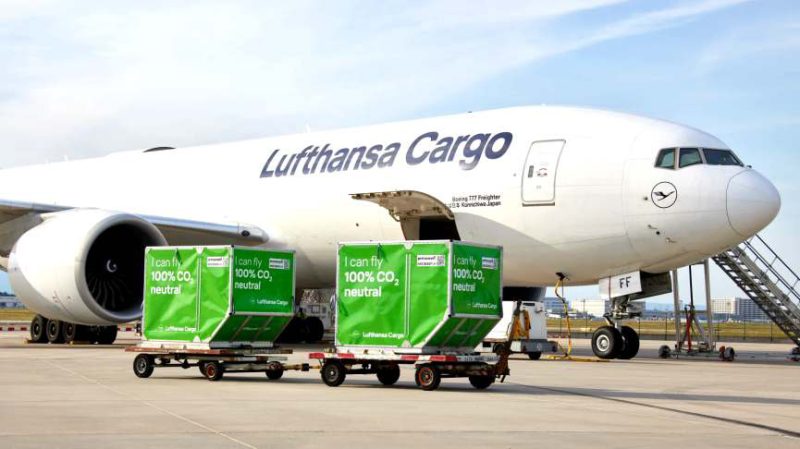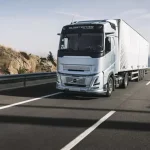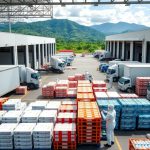Green cargo movement is critical to combating climate change
About 45 airlines have so far adopted sustainable fuelling and over 14 billion liters worth of Sustainable Aviation Fuel (SAF) are under different stages of purchase agreements.
By R.Chandrakanth
Aviation accounts for over 2% of global energy-related CO2 emissions, having grown faster in recent decades than road, rail or shipping. And if no green measures are adopted in the industry, it could continue to negatively impact the planet.
The global air freight market is expanding, projected to reach USD 490 billion by 2030, up from USD 295 billion in 2021 (CAGR of 6%), according to a report from Straits Research.With passenger numbers expected to double to 8.2 billion by 2037, the issue of CO2 emissions persists, despite ongoing efforts related to low-carbon fuels, improvements in engines and aerodynamics, operational changes, among other things.
Terms such as ‘sustainable air cargo’, ‘green logistics’, ‘green cargo’ and moreare gaining currency as the aviation industry is adopting strategies and making investments to ensure that the future of air cargo is aligned with the Sustainable Development Goals (SDGs) or ‘Global Goals’ of the United Nations.
As shippers, freight forwarders, and their air cargo stakeholders are increasingly demanding precise flight CO2 emission information, an accurate and standardized calculation methodology is critical, the International Air Transport Association (IATA) has adopted the Air Cargo Carbon Footprint (ACCF) in 2014 and updated in 2021. This cargo CO2 emissions measurement methodology provides the most accurate calculation results and transparency to everyone interested in understanding the carbon footprint at the shipment level.
Airlines, logistics companies, freight forwarders in the loop
Staying abreast of these initiatives are some air cargo players and leading from the front are giants such as FedEx, UPS, DHL, DB Schenker, Qatar Airways Cargo, Lufthansa Cargo, Seko and a few others. They are aggressively working towards achieving carbon neutrality by 2050 and, going by reports, some of them may achieve that before the deadline.
Take for instance UPS, the world’s largest package delivery company, it has 1 million plus cleaner miles driven every day; has purchased 156 million gallons of alternative fuel; and has invested $1 billion in alternative fuels and advanced technologies.
In August last year, UPS opened in Pennsylvania its fourth largest US distribution hub, home to the largest natural gas fuelling station in UPS’s network. The new renewable natural gas (RNG) fuelling station will remove 8 million gallons of diesel fuel per year; help UPS reach 40% alternative fuel in ground operations by 2025; and lower carbon footprint.
UPS‘Green Exporters Program’
Also last year, UPS launched a ’Green Exporters Programme’ (GEP), offering training and education to small and medium sized businesses in Mexico, improving supply chain and boosting access to new markets for sustainable products. Currently, the GEP is helping 131 businesses in Mexico and is now expanding the programme to the UK. Sustainably sourced products include sustainable garments such as fabrics made from eco-friendly resources. Getting these green goods to new markets can be tricky, but UPS is there to help businesses navigate the process to access this $150 billion market.
FedEx’s each EV saves 1.3 tons of carbon emissions
Similarly, FedEx Corp in June 2022 received its first 150 electric delivery vehicles from BrightDrop, decarbonizing last-mile delivery. The company plans to transform its entire parcel pickup and delivery (PUD) fleet to all-electric, zero-tailpipe emissions by 2040.
Also in India, FedEx Express deployed 30 Tata Ace EVs in Delhi as part of its larger goal of carbon-neutral operations. FedEx has a goal of converting 50% of its global pickup and delivery vehicle purchases to electric by 2025, with that increasing to 100% by 2030. Each new electric vehicle added to the FedEx fleet is estimated to save up to 1.3 tons of carbon emissions annually.
Lufthansa Cargo’s recycled plastic initiative
Lufthansa Cargo is working on becoming the world’s most efficient cargo airline. With nearly 99% of its carbon footprint caused by flying, the airline’s greatest CO2-saving potential lies in the air. However, it is working hard to achieve CO2-neutrality in all its ground processes by 2030. In addition, the airline is constantly looking for new ways to avoid waste and plastic.
Each year, Lufthansa Cargo needs about 500 tons of plastic film worldwide to protect its freight during transport. As part of its sustainability strategy, the company has been working for many years to reduce the need for plastic and to establish the most environmentally friendly handling possible at its approximately 300 stations around the globe.
In September 2022, Lufthansa Cargo became the first cargo airline to use a new type of film that consists of 10 percent recycled plastic and is also one micrometer (one µ) thinner than previous films. This means that about two kilograms less film is needed on each cargo flight.
DB Schenker focusing on green supply chains
DB Schenker, a leading global player in multimodal transportation, deployed its first two electric trucks in Berlin back in 2017. To date, the e-fleet in Europe’s largest land transport network has grown to 79 vehicles.
DB Schenker is able to make CO2-free general cargo deliveries from more than 60 locations across Europe. In 24 European cities, a total of more than 60 cargo bikes are used in urban transport.
DB Schenker is focusing on green supply chains of the future and has already completed over 1.5 million kms with electrically powered trucks in its European land transport network. The logistics company is scaling up its efforts to shift its urban collect and delivery fleet completely to electric drives by 2030.
DHL invests in ‘Greenplan’ and more
DHL, global logistics player, has invested in ‘Greenplan’, a route-optimisation planning solution which uses a unique algorithm, even considers local traffic flow and the time of day. DHL has been using electric vehicles for many years now—around 20% of its fleet is zero-emissions vehicles, aiming at electrifying 60 % of their ground fleet by 2030.
At DHL, offsetting CO2 is one option, but in-setting is a way how one can really help to reduce CO2. DHL also helps cargo players to reduce Scope 3 footprint, having recently made one of the largest SAF deals in history, with BP and Neste committed to supplying with over 800 million litres until 2026.
CO2 savings on a lifecycle basis for this deal only is estimated to be equivalent to annual greenhouse gas emissions of approx. 400,000 passenger cars. Striving to achieve net-zero by 2050, DHL has since purchased 33 million litres of SAF and plan to modernise their aircraft solutions.
Qatar Airways Cargo, first cargo carrier to join IATA Co2nnect platform
Qatar Airways Cargo became the first cargo carrier in 2021 to join the IATA Co2NNECT platform and offer a customised environmental solution for its clients. Kuehne+Nagel, one of the world’s leading freight forwarders, was the launch customer for the platform, in line with their commitment to sustainability.
To mark this partnership, on November 1, 2021 Qatar Airways Cargo operated the first carbon-neutral air freight shipments from Doha to Frankfurt, Zaragoza, Liège and Paris.
This new chapter of the voluntary carbon offsetting program, built under an IATA umbrella, establishes an industry milestone to accelerate the decarbonisation of aviation and enables air cargo shipments to become carbon neutral by offering an integrated carbon calculation and offset solution between Qatar Airways, shippers, and freight forwarders such as Kuehne+Nagel. Itl provides customers assurance that the credits bought to offset these emissions are from projects delivering independently verified carbon reductions, as well as wider environmental and social benefits.
The pilot project was launched on four routes, with plans to extend to the rest of its cargo network of over 60 freighter destinations and over 140 passenger destinations worldwide.
Qatar Airways Group Chief ExecutiveAkbar Al Baker, then said: “As Qatar Airways first launched its carbon offset programme for passengers in 2020, we are pleased to now offer them the option of transporting the air cargo in a CO2 neutral way in the future. Qatar Airways Cargo has always been at the forefront of industry initiatives. I am proud of our efforts to support aviation industry in achieving the ambitious carbon emission reduction targets.”
Cool Nordic Cargo Hub
Finnair, Finnish airline, is also making news with the COOL Nordic Cargo Hub at Helsinki airport. The green air cargo terminal design puts environmental sustainability in air cargo front and centre. The terminal construction and design arein line with BREEAM (Building Research Establishment Environmental Assessment Method) standards.
The hub has 1,200 solar panels providing 10% of the terminal’s energy; Critical automated storage area does not require lighting to function; COOL terminal is located next to wide-body aircraft stands to reduce transport time; Truck management system alleviates unnecessary journeys and vehicle idling; Maintenance and waste management schedules are highly optimised to cut down visits; Automation directs COOL terminal forklifts to nearest task; Warehouse automation assigns incoming goods to nearest available storage location; and Dedicated and separated areas for general cargo and temperature-sensitive goods.
Airlines, freight forwarders, logistics companies are all under pressure to reduce greenhouse gas emissions. Presently, about 45 airlines have adopted sustainable fuelling and over 14 billion litres worth of SAF are under different stages of purchase agreements. Indeed, Green air cargo transport thus has become integral to any sustainable growth, besides helping mitigate the climate change issue by reducing the percentage of emissions.
The future of green air cargo transport depends upon how quickly all the stakeholders adopt sustainable practices, both in the air and on the ground. Imagine the amount of pressure on air cargo operators with over 7.4 billion parcels flown around the world each year and with flourishing ecommerce, this is going to get further catapulted, calling for increased investments in green cargo movement. Combating climate change is critical.














